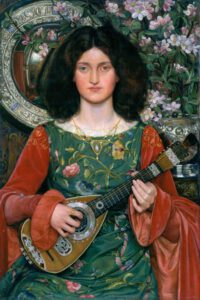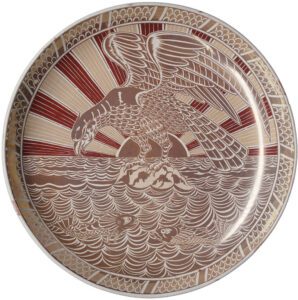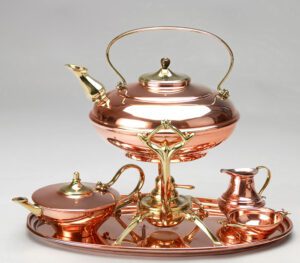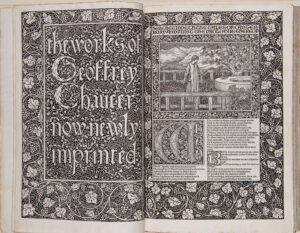
William De Morgan: Eagles Dinner Plate
James Cassell
From the Yale Center for British Art

Yale University in New Haven holds the largest collection of British art outside the United Kingdom. The museum’s founder and chief benefactor, Paul Mellon, a 1929 Yale alumnus, had gold-certified ties to England. First, his mother was English and many of his childhood summers were spent in the English countryside visiting her family. Mellon studied at Cambridge where he developed a passion for racehorses which led to his becoming a leading breeder. His father, the wealthy banker, Andrew Mellon, was briefly the American ambassador to the Court of St James in the 1930s. So one could credibly argue that Mellon’s Anglophilia had a solid foundation. The first British painting Mellon purchased was Pumpkin with a Stable-lad by George Stubbs. Eventually, his entire collection of British art went to Yale. He also financed the construction of the building designed by Louis Kahn.
When the pandemic was more abstract than real in early March, and the doors to museums were still open, I walked to the Yale Center for British Art, crossing the long stretch of the historic New Haven green to get there. Designed with great foresight by dissenting English Puritans in the 17th century, this green, at 16 acres, was large enough to accommodate the 144,000 people who they believed would be spared in the Second Coming of Christ.
I was going to see the work of another group of English dissenters, the Pre-Raphaelites, who had their share of members whose religious fervor matched that of the Puritans (see, for example, William Holman Hunt’s The Finding of the Saviour in the Temple (1854-60), but who were also concerned with more secular matters such as social reform and artistic vision. The exhibit, ‘Victorian Radicals: From the Pre-Raphaelites to the Arts & Crafts Movement’, draws from extensive holdings in the Birmingham Museums which, with its U.S. partner the American Federation of Arts, organized the exhibit.
My encounter with the Pre-Raphaelite artists (and poets) began a half century earlier in the 1960s, in a class at Georgetown called Conflict, Alienation and Negativity. I remember seeing a reproduction and being quite taken with the rapturous Beata Beatrix painting by Dante Gabriel Rossetti. Shortly thereafter, I visited the Delaware Art Museum in Wilmington, which houses the largest collection of Pre-Raphaelite art outside Britain.
During the cultural and political upheaval of the 1960s – assassinations, the high-stakes race to put a man on the moon, marches for civil rights, protests against the Vietnam War, a back-to-the-land movement – the fierce romanticism and utopian dreams of the Victorian Pre-Raphaelites touched a chord. No doubt their popularity then can also be explained as a reaction to the rigid hold that late modernism had on art, up to and including Clement Greenberg’s orthodoxy. Modernism, especially its late manifestation in abstract expressionism, had stripped art of figuration and narration. A renewed interest in the Pre-Raphaelites signified that there was a place for both.

The Pre-Raphaelite Brotherhood (PRB) was founded in 1848, the same year that Marx and Engels published The Communist Manifesto, revolution swept through France and other parts of Europe, and the Chartists rallied – in the presence of the army – on Kennington Common in South London calling for workers’ rights. For Rossetti, William Holman Hunt and John Everett Millais, the PRB leaders barely out of their teens, a radicalized social consciousness was inseparable from an awareness of the stifling conformity and confining rules of the Royal Academy. They proceeded to challenge what was considered ‘correct’ in Victorian artistic practice. They disdained the over-emphasis on elements of science applied to art, such as Renaissance perspective, and what they perceived as the lifelessness of much of the art that received Academy approval.
The Pre-Raphaelites had front-row seats to the dying out of the old order, a decline that began in the 18th century – power that had been based largely on inherited land and wealth – and the ascent of capitalism in the form of rapacious and brutalizing industrialization and mechanization that went in tandem with worker exploitation and social dislocation.
The movement constituted a retreat from a rationalist–dominated status quo, offering instead a look back to the Middle Ages to find a way forward in the Victorian age. Of course, like most critiques of the status quo in relation to the past, theirs suffered from an overly rosy assessment of the conditions of life in earlier times. While agrarian society may have seemed preferable from the distance of a century or more, the reality was that land had always been in the hands of a few, and the peasantry were essentially powerless and at the mercy of the landowners for their survival.
In their opposition to the art establishment, the Pre-Raphaelites advocated an art whose first principle was beauty. Through the use of allegory, they believed art should convey moral lessons through stories from the Bible and mythological legends that were familiar to even the most uneducated, and were often handed down orally.
Their radical social agenda called for labor that was meaningful and humane, with the goal of achieving a more equitable distribution of wealth. Henry Wallis’s painting, The Stone Breaker (1857), for example, is a commentary on Victorian laws that mandated work, often physically harsh, for those who could not find regular employment, such as an entire day spent breaking up stone to build a road.
In the painting, a young man in sullied work clothes is hunched against a berm and some rocks, his head bowed as though he were asleep. His figure blends into the brown-black and burnt sienna colors of the earth. Near twilight, the landscape of trees in the distance has become dark blue, and the sky a fading sallow yellow with narrow bands of violet. The man, who has fallen through the cracks of the industrial age, perhaps unable or unwilling to work in a factory, has died from overwork and exhaustion.
The modern belief, whose origins stretch back at least to the early 18th century, that scientific and technological advancement was somehow synonymous with a higher level of civilization, was belied by the ravages of the factory system in the 19th century, blatantly visible to all with sensitive eyes. In the factories, the clock ruled, and the goal was to produce as much in the shortest amount of clock-time. From the factory and its emphasis on time, all aspects of cultural life were affected. Musing, immobility, singing, directionless wandering were seen as wasteful and were discouraged.
In their alienation, the Pre-Raphaelites dreamed of a simpler, gentler and more aesthetically infused way of life. William Morris and the formation of ‘the Firm,’ the artists operating at Red Lion Square, and the Arts and Crafts Movement that it spawned – all of which originated in Pre-Raphaelite ideas and attitudes – found models in the guild system of the Middle Ages. Art and social critic John Ruskin’s work, The Nature of Gothic (from The Stones of Venice), was a bible to Morris and Edward Burne-Jones.
In London in 1888, architect Charles Robert Ashbee founded the Guild and School of Handicraft in the slums of Whitechapel. The guild was a center for textiles and metalwork made by craftsmen and apprentices living communally, many of them socialists, and many drawn from the ranks of the poor. In creating products by hand, the guild could achieve its two main goals: providing an alternative to dehumanized labor while, at the same time, eliminating poverty, which was often the consequence of unforeseen market fluctuations and worker exploitation. Although the guild ran into financial problems later on, it inspired the creation of other guilds in the early 20th century and had an influence on the rise of Western socialism.

As he championed art that was true to Nature, both in theme and assiduous painterly detail, and believed that beauty was art’s ultimate goal, Ruskin was the PRB’s greatest celebrity defender. However, fickle and prickly, Ruskin didn’t hesitate to both praise and criticize a painting by a PRB artist if, in his mind, the work veered too far from his ideals. Ruskin described James Campbell’s The Wife’s Remonstrance, part of an exhibit by the Society of British Artists in London in 1858, as “by far the best picture … full of pathos, and true painting.” However, he criticized the painting’s depiction of poverty as an example of a Pre-Raphaelite penchant for “ugly things better than beautiful ones.”
Though the Pre-Raphaelites presented a slower, quieter and more romantic (and romanticized) world, their beauty is often tinged with pathos, as in Millais’s The Blind Girl (1854-56). The vividness of the palette – the earthy sienna tones of the girl’s cape and gown, the shimmering pale green of the meadow in the background, the far distant rainbow – is juxtaposed with the knowledge that she is excluded from this visual paradise. The sign around the girl’s neck reads, ‘Pity the Blind.’ A younger girl who sits on her lap, perhaps her sister, stretches her body around to look back at the rainbow.
Often indifferent to academic artistic criteria, PRB painters were not averse to flattening pictorial space, similar to 15th century Florentine frescoes; or working with local color, using it lushly. “The colour of the Pre-Raphaelites was equally as uncompromising as their form,” wrote English art historian, William Gaunt in his book, The Pre-Raphaelite Dream. “They made the green of grass intensely green, the yellow of a flower as yellow as could be, the purple of a dress an impassioned and vibrant purple …”
In Arthur Hughes’s The Long Engagement (ca. 1854-59), rich in naturalist precision and symbolism, a betrothed couple stand beside a tree in the woods. A shadow enfolds the brown-clothed man, his face showing frustration, while the sad but hopeful face of the woman, who is in the center of the frame, is a luminous pearl. Her vibrant purple cape and the tactile green ferns and moss enhance the painting’s feeling of sensual melancholy. The painting suggests that marriage hinges on financial stability, and for the vast majority of couples who must adhere to the custom of pre-marital celibacy, that means a prolonged and difficult delay.

Unlike the French Impressionists rebelling against the strictures of the Paris Salon, and who sought in their canvases a sense of how things looked and felt, the PRB artists sought realism. One can speculate whether they might also have been responding to the advent of the daguerreotype. No doubt, in sensibility, they were influenced by the German Nazarene movement which, arose at the beginning of the 19th century in reaction to the perceived aridity and absence of spirituality in art since the Renaissance. Similarly, the Pre-Raphaelites leaned toward making art that was more devotional, whether drawn from the Bible or devotional in the sense of an eroticized spiritual love between a man and a woman. Or, in the case of the work of Simeon Solomon, between a man and a man.
Solomon was in the second wave of PRB artists. Jewish and unapologetically homosexual, he has only recently been given his due, despite his extraordinary accomplishments in treating both Biblical and androgynous themes in his work. Burne-Jones, a close friend, told Solomon that he was “the greatest artist of us all; we are mere schoolboys compared with you.”
With its Medievalist bent, the Pre-Raphaelite movement would continue to draw interest at various times during the 20th century. There was a particular potency, however, in the 1960s revival. Just as Victorians witnessed the destructiveness wrought by early industrialization, the post-World War II generation grew up in the aftermath of the devastation caused by advanced weaponry. The world had been brought to the brink of annihilation in the 1950s Cold War, as symbolized by air drills in classrooms where children hid under their desks. Economic success and access to a greater number of goods went side by side with the absurdity of living amidst the threat of extinction.
The growth of a counter-culture and the flowering of communes in the late 1960s, echoed Morris, the guilds and the spirit of agrarian community that the Pre-Raphaelites found so appealing. In the art world the Ruralist Movement begun by Peter Blake and Ann and Graham Arnold took their lead from the Pre-Raphaelites. We, too, longed for a new moral and spiritual order that would value human achievement not through tangibles, but through the immeasurable; the perennial joys, for example, derived from simple earthly activities such as looking up at the stars or witnessing over time the growth of a tree; whittling a piece of wood into an object; when every human being’s creative potential would be nurtured; when there would be alternatives to mass-produced goods; and when beauty was woven into the patterns of everyday life.
Volume 35 no 1 September / October 2020

